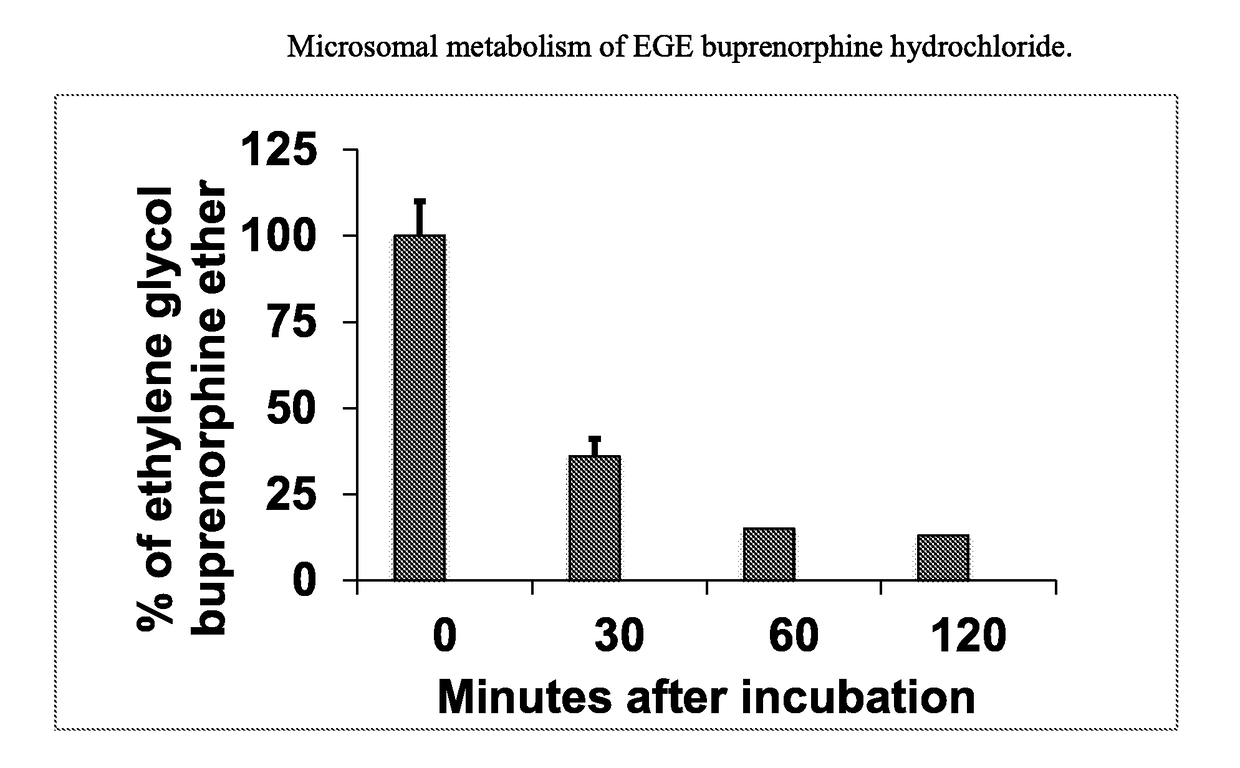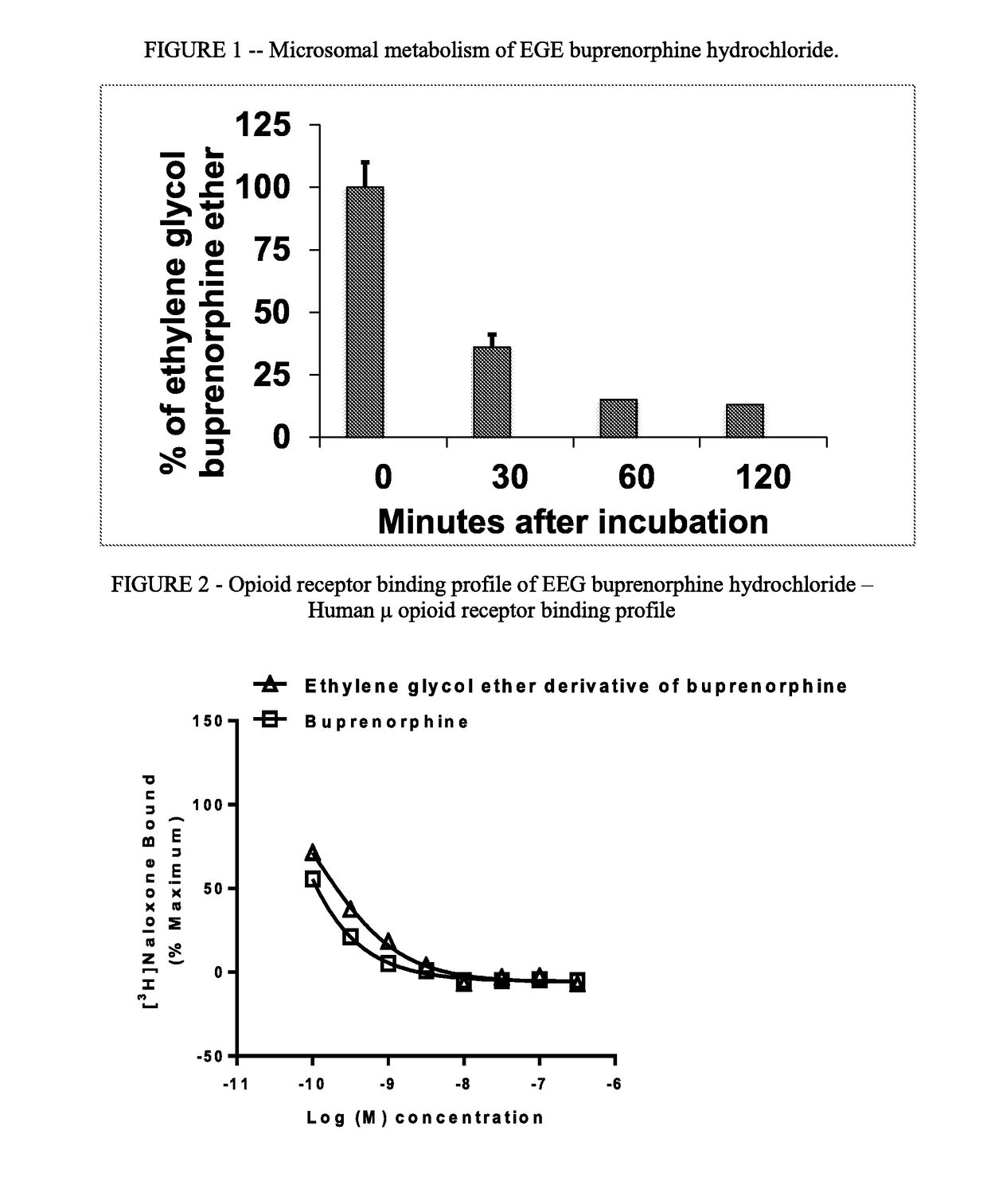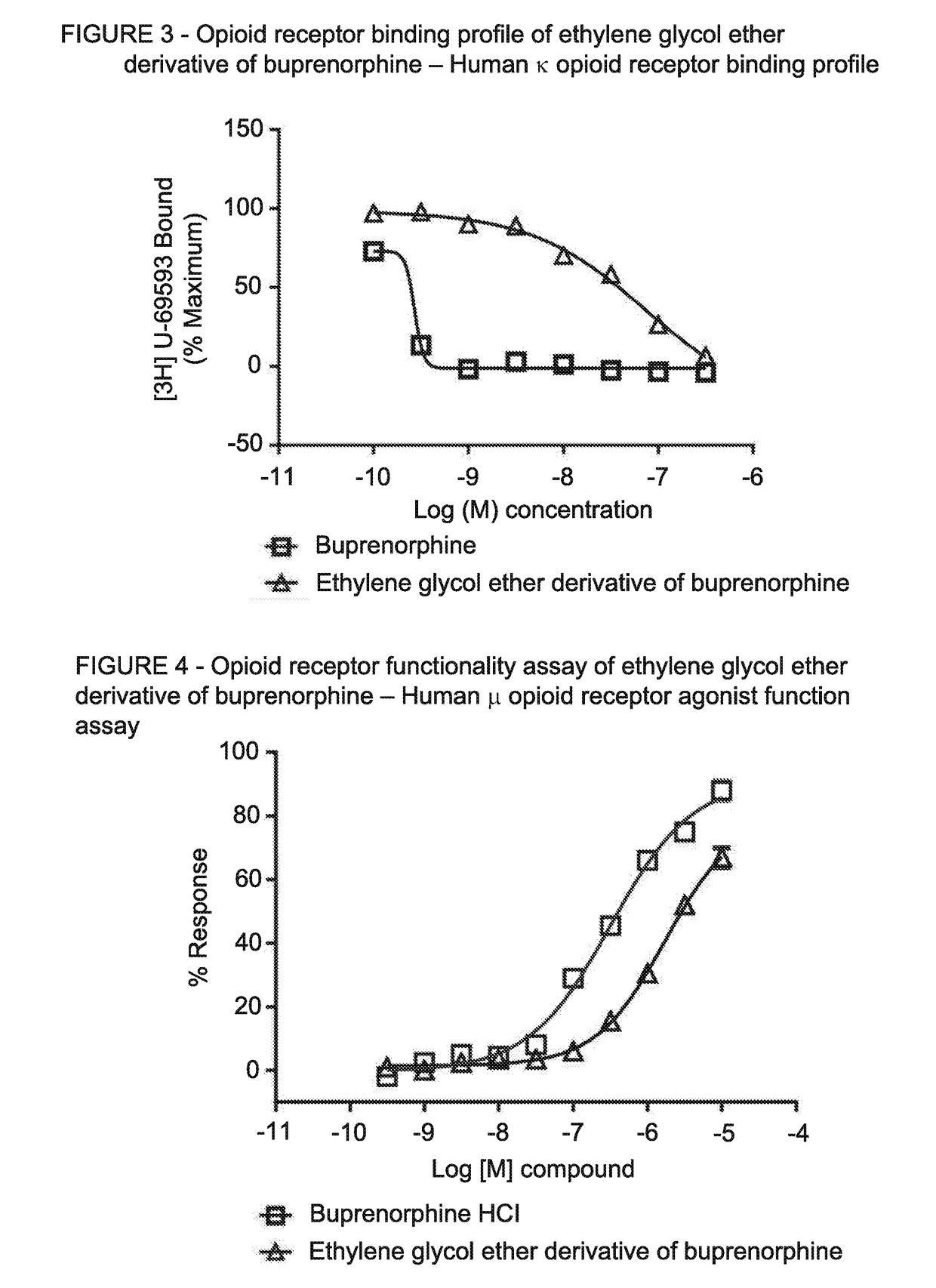Ethylene glycol ether of buprenorphine
a technology of ethylene glycol and buprenorphine, which is applied in the field of ethylene glycol ether of buprenorphine, can solve the problems of reduced functional ability and productivity, reduced quality of life, and reduced productivity, etc., and achieves the effects of reducing the risk of side effects, and reducing the effect of drug side effects
- Summary
- Abstract
- Description
- Claims
- Application Information
AI Technical Summary
Benefits of technology
Problems solved by technology
Method used
Image
Examples
example 1
Synthesis
[0058]The hydrochloride salt of EGE buprenorphine was synthesized in 3 steps:
[0059]Step 1—synthesis of intermediate 2: A 250-mL, three-neck round bottom flask equipped with a magnetic stirrer, addition funnel, and nitrogen inlet was charged with buprenorphine HCl (5.0 g, 10.68 mmol, 1 equiv), anhydrous DMSO (30 mL) and powdered potassium carbonate (2.94 g, 21.37 mmol, 2 equiv). The resulting mixture was heated to 55° C. and 2-(2-bromoethoxy)tetrahydro-2H-pyran (Intermediate 6) diluted with anhydrous DMSO (20 mL) was added dropwise via addition funnel over a period of 1 hour. This mixture was heated at 55° C. overnight. TLC indicated the reaction is complete. The reaction was cooled to room temperature, diluted with dichloromethane (10 vol) and washed with water (15 vol). The organic layer was separated, washed with brine, dried over magnesium sulfate and concentrated. The crude product was column chromatographed (0-5% MeOH / DCM) to yield the product 2 as a foamy solid (5.4 g...
example 2
In Vitro Assay: Metabolic Stability of EGE Buprenorphine
[0063]Incubations of EGE Buprenorphine hydrochloride (e.g., 1 μM) with human liver microsomes (e.g., 1 mg protein / mL) were carried out using a Tecan Liquid Handling System (Tecan), or equivalent, at 37±1° C. in 0.2-mL incubation mixtures (final volume) containing potassium phosphate buffer (50 mM, pH 7.4), MgCl2 (3 mM) and EDTA (1 mM, pH 7.4) with and without a cofactor, NADPH-generating system, at the final concentrations indicated in a 96-well plate format. The NADPH-generating system consisted of NADP (1 mM, pH 7.4), glucose-6-phosphate (5 mM, pH 7.4) and glucose-6-phosphate dehydrogenase (1 Unit / mL). EGE Buprenorphine was dissolved in aqueous methanolic solution (methanol 0.5% v / v, or less). Reactions were started typically by addition of the cofactor, and stopped at four designated time points (e.g., up to 120 min) by the addition of an equal volume of stop reagent (e.g., acetonitrile, 0.2 mL containing an internal standar...
example 3
Receptor Binding Activity
[0067]This example illustrates the binding of EGE buprenorphine hydrochloride to the μ-opioid receptor and x-opioid receptor.
A. Human μ Opioid Receptor Binding Assay
[0068]Membranes from Chinese Hamster Ovary cells expressing the human μ opioid receptor (Perkin Elmer #RBHOMM400UA) were homogenized in assay buffer (50 mM Tris, pH 7.5 with 5 mM MgCl2) using glass tissue grinder, Teflon pestle and Steadfast Stirrer (Fisher Scientific). The concentrates of the membranes were adjusted to 300 μg / mL in assay plate, a 96 well round bottom polypropylene plate. The compound to be tested was solubilized in DMSO (Pierce), 10 mM, then diluted in assay buffer to 3.6 nM. In a second 96 well round bottom polypropylene plate, known as the premix plate, 60 μL of 6× compound was combined with 60 μL of 3.6 nM 3H-Nalaxone. From the premix plate 50 μL was transferred to an assay plate containing the membranes, in duplicate. The assay plate was incubated for 2 h at room temperature...
PUM
| Property | Measurement | Unit |
|---|---|---|
| time | aaaaa | aaaaa |
| volume | aaaaa | aaaaa |
| pH | aaaaa | aaaaa |
Abstract
Description
Claims
Application Information
 Login to View More
Login to View More - R&D
- Intellectual Property
- Life Sciences
- Materials
- Tech Scout
- Unparalleled Data Quality
- Higher Quality Content
- 60% Fewer Hallucinations
Browse by: Latest US Patents, China's latest patents, Technical Efficacy Thesaurus, Application Domain, Technology Topic, Popular Technical Reports.
© 2025 PatSnap. All rights reserved.Legal|Privacy policy|Modern Slavery Act Transparency Statement|Sitemap|About US| Contact US: help@patsnap.com



